Turtle release by Mai Khao Turtle foundation
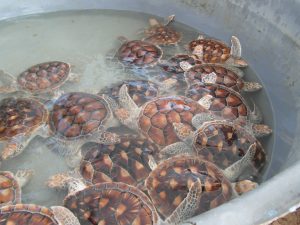
Sarah Kench, the GM and Course Director, Kath Ridley the tour leader of Scuba Adventure and Debbie Woods The Customer Service manager all went along to support the event held on the beach at Mai Khao, along with Jade, Debbie’s 1 year old daughter.
There were activities such as batik painting and turtle awareness going on throughout the afternoon along with light refreshments and a monks blessing for the new to be released green turtles.
After waiting to queuing in a busy registration Scuba Cat were allocated number 73 for release, this was a 10 month old green turtle, Sarah was the one elected to release it.
After some training we were called to beach in groups of 5, this allowed the turtles enough space to comfortably be released without big crowds around them which could cause stress. They were taken from holding tanks to the water edge and set free, the waves then helped them out to sea.
Phuket’s sea turtles face multiple threats and their numbers have severely depleted in recent years. Commercial fishing kills thousands of them every year. Many more die from eating or becoming trapped in plastic debris littering the ocean, not to mention entanglement in fishing nets and being hit by speedboats.
Every 2,500 baht raised pays for the rehabilitation of one turtle and its release back into the Andaman Sea. The work done by the Mai Khao Marine Turtle Foundation (founded by JW Marriott Phuket Resort & Spa), the Injured Turtle Rehabilitation Program (under the Phuket Marine Biological Center) and the Turtle Hatchery Program (under the Royal Thai Navy) is possible thanks to ongoing financial support from the Phuket community.
Phuket’s sea turtles are facing multiple threats and their numbers have severely depleted in recent years. Commercial fishing kills thousands of them every year. Many more die from eating or becoming trapped in plastic debris littering the ocean.
Mai Khao beach and the northern end of the adjacent Nai Yang beach are the only beaches where turtles lay their eggs in Phuket . These two locations have a long natural deserted beach stretching more than 17km. They form part of the Sirinath National Park, which is a protected marine and coastal area.
This is a nesting area of the giant Leatherback Turtle, one of the world’s most ancient species. These turtles on average weigh 450 kg. However, the Leatherback population is fast diminishing and its status is very critical. It is the only turtle without a true protective shell, though its outer protection is leathery scale-less skin – hence its name.
The breeding season of the turtles is November to March. The females come ashore just after dusk and return to the ocean as dawn breaks. The nesting site is selected and they dig a small pit using the rear flippers where they lay between 40 and 180 eggs, they try to conceal the nest once they finished by covering it with sand. The whole process takes about 1 hour. If left to nature the hatchlings will emerge after about 60 days digging their way out of the pit , usually at night so it is cooler and run towards the sea. House lights and hotel developments along the beach can disoriented the young turtles causing them to actually crawl the wrong way going away from the sea. Some large Phuket resorts have focused their attention on ensuring that turtles stand a chance of survival in the Phuket region by making the beach area environmentally friendly to the nesting turtles.
At nesting time environment groups and the local villagers of Mai Khao work very hard to protect the eggs. They take the eggs to their hatchery, where the baby turtles are protected from the vagaries of nature as well as human exploitation. During the breeding season, the local villagers patrol the beaches at night and keep records of the eggs that have been laid.
The Mai Khao Marine Turtle Foundation was launched in 2002 and raises funds and awareness for the plight of the critically endangered giant leatherback turtles that nest in the area. It also co-ordinates with the Phuket Marine Biological Centre (PMBC).
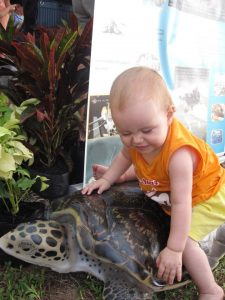


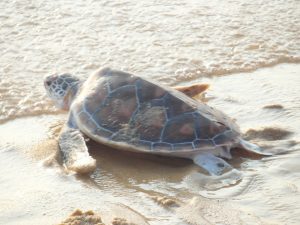

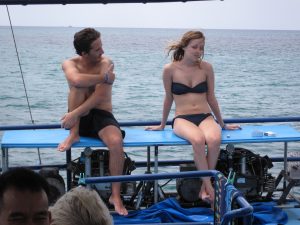
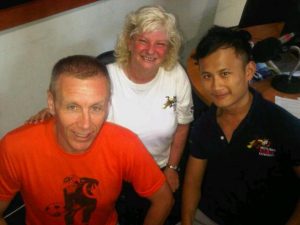








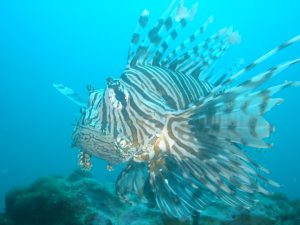

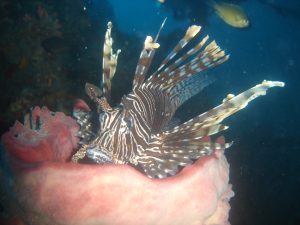













Scubacat Community